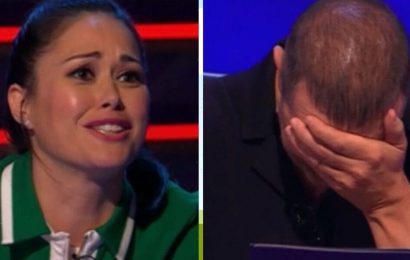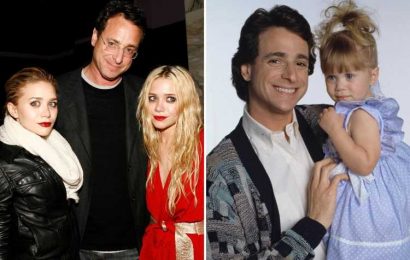While it is frequently stressed that The Crown is not always a historically accurate representation of the royal family, that fact has done little to quell interest in the institution led by Queen Elizabeth II.
The monarch died on September 8 at the age of 96, with her loved ones, including son Charles – who is serving as the new King – jetting to be by her side.
Buckingham Palace confirmed the news in a statement, which read: ‘The Queen died peacefully at Balmoral this afternoon.
‘The King and The Queen Consort will remain at Balmoral this evening and will return to London tomorrow.’
Much of her life has been explored by the episodes of the Netflix drama so far, with season five due to be released soon.
So far, viewers have watched two actors portray the Queen in the Netflix series – first Claire Foy, as Princess Elizabeth who inherits the throne, and then Olivia Colman as the middle-aged monarch.
Queen Elizabeth II dead: What happens next?
Her Majesty Queen Elizabeth II has died after 70 years on the throne, with her death announced by Buckingham Palace on September 8, 2022.
She died at the age of 96 at her home in Balmoral, with her son, the now King Charles, and daughter Princess Anne by her side.
- What happens next following the death of the Queen
- Will there be a bank holiday to mourn the Queen?
- Britain officially enters period of mourning after death of Queen
- King Charles coronation: When might it be and will it be a bank holiday?
- Map shows procession route for Queen lying in state
- Sign the book of condolence to Her Majesty
Follow Metro.co.uk’s live blog for the latest updates.
Imelda Staunton is set to portray the head of state in seasons five and six, which will follow the royal family from the 1990s to present day.
The Crown has done much to educate people across the globe about the goings-on of royal life, but while some scenes are depicted close to how they played out in reality, others take a more dramatised approach.
So from the intruder who showed up in the Queen’s bedroom to the monarch’s relationship with Margaret Thatcher, what did The Crown get right and wrong about Queen Elizabeth II?
Queen’s conversation with intruder Michael Fagan
In one of the most memorable moments from The Crown’s fourth season, the series introduced viewers to a man called Michael Fagan, who was experiencing hardship and financial strain in his life.
After successfully breaking into Buckingham Palace on one occasion, escaping before he is caught, on a second occasion, he finds his way to the Queen’s bedroom, where she wakes up and he asks her to save the country from the impact of then-prime minister Thatcher.
While Fagan did break into the Palace in real life, in an interview conducted with the BBC in 1993, the intruder said that she simply told him to get out.
So while their conversation was powerful to watch and we can’t know for sure what was said between them, it did not happen as shown on The Crown in the real event.
How she dealt with her sister’s desire to marry
The differences between Princess Margaret and Queen Elizabeth are made apparent from the very start of The Crown, with the latter prioritising her responsibility as a figurehead and the former depicted as seeking out the spotlight.
The drama portrays the real-life relationship between Princess Margaret and Peter Townsend, who proposed to her in 1953 and was 16 years her senior.
In The Crown, Claire Foy’s Elizabeth asks Vanessa Kirby’s Margaret to wait when initially asked for permission for her younger sister to marry Townsend.
To view this video please enable JavaScript, and consider upgrading to a webbrowser thatsupports HTML5video
While in the drama, the Queen eventually flat out denies Margaret’s request, in real life, the princess may have decided herself to end the engagement.
In a statement released on October 31 1955 to mark the end of their relationship, she said: ‘I would like it to be known that I have decided not to marry Group Captain Peter Townsend. I have been aware that, subject to my renouncing my rights of succession, it might have been possible for me to contract a civil marriage.
‘But mindful of the Church’s teaching that Christian marriage is indissoluble, and conscious of my duty to the Commonwealth, I have resolved to put these considerations before any others.’
As with many royal matters, the true answer may only be known to those behind the scenes.
The monarch’s relationship with Margaret Thatcher
The Crown shows the Queen and Thatcher as having a fairly frosty relationship, with the prime minister failing to fit in during a trip to Balmoral and frequently at odds with the monarch during private audiences.
It appears to be true that the pair didn’t see eye to eye on several matters, with Dean Palmer writing in his book The Queen and Mrs Thatcher: An Inconvenient Relationship: ‘The palace thought Thatcher vulgar, and the prime minister thought royalty was irrelevant.’
Meanwhile, John Campbell wrote in his book The Iron Lady: Margaret Thatcher, from Grocer’s Daughter to Prime Minister: ‘The Queen was said to dread her weekly audience with her Prime Minister because Mrs. Thatcher was so stiff and formal.’
Nonetheless, the Queen still respected Thatcher by the time her tenure as prime minister came to an end, awarding her the Order of Merit as portrayed on the show.
However, the recognition was given two weeks after Thatcher’s resignation, rather than during their final audience together.
Her response to the Aberfan disaster
One of the most shocking aspects of the Queen’s depiction on The Crown was in response to the Aberfan disaster, when the monarch, played by Colman, was shown feigning emotion over the tragedy.
The Aberfan disaster of October 21 1966 claimed 144 lives in the Welsh village, when a collapse of a colliery spoil tip caused destruction and the deaths of 28 adults and 116 children.
The Queen visited Aberfan eight days after the disaster, when she was joined by Prince Philip, the Duke of Edinburgh.
In real life, it’s said that the Queen’s response to Aberfan was one of her biggest regrets, as she is said to have regretted waiting eight days to travel there, with her husband having travelled to the village the day after the spill.
In The Crown, Colman’s version of the Queen says in private: ‘They deserved a display of compassion, of empathy, from their queen. They got nothing. I dabbed a bone-dry eye and by some miracle no one noticed.’
Numerous fans of the drama expressed their fury over the fictional take on her reaction.
The Queen’s argument with Prince Philip
The members of the royal family are well-versed in keeping their personal lives as private as possible.
However, in 1954 while on a royal tour in Australia, a film crew inadvertently witnessed the Queen and her husband arguing.
It’s said that after the argument, the Queen turned to the camera crew and said: ‘I’m sorry for that little interlude but, as you know, it happens in every marriage. Now, what would you like me to do?’ after which the footage was handed over.
This interaction was featured in a season one episode of The Crown, although the real footage has never been seen.
Her meeting with the US First Lady Jackie Kennedy
In the 1960s, the worlds of the British royal family and the US president collided when the Kennedys were welcomed into Buckingham Palace.
In the season two episode, Jackie and Queen Elizabeth II are shown bonding over an intimate chat, before the monarch finds out that the First Lady supposedly spoke out about her and the Palace in a derogatory way.
While there are claims that Jackie did indeed share some negative remarks on the way in which the Palace was decorated, the idea of the Queen hearing about the comments may not be based on fact.
Robert Lacey, historical consultant on The Crown, told Vogue: ‘I think that the personal tension between Elizabeth and Jackie is speculative. I’m not saying it didn’t exist – you can’t say it’s false, you can’t say it’s true. I think it’s perfectly plausible that the Queen felt upstaged by Jackie.’
Source: Read Full Article








